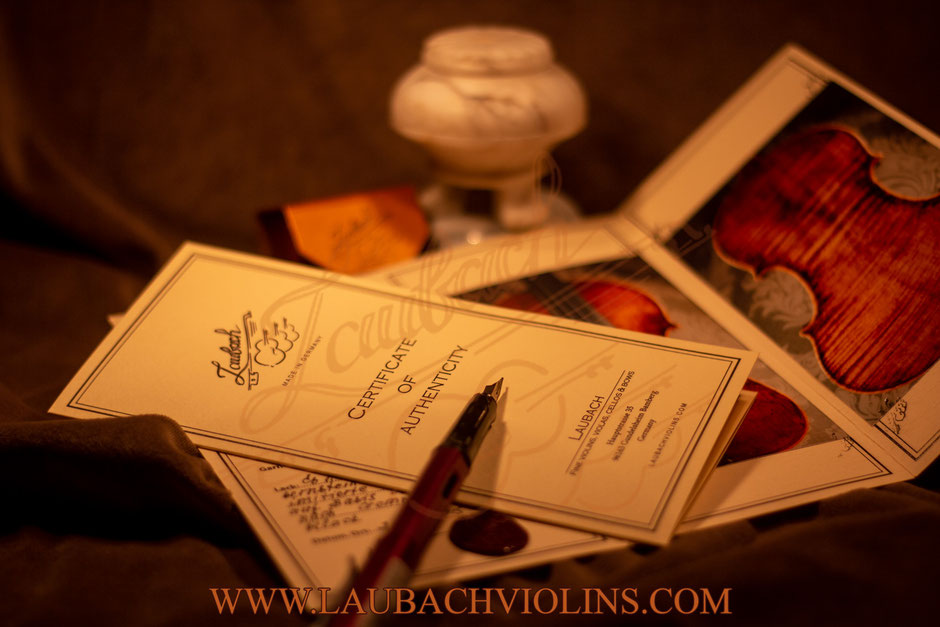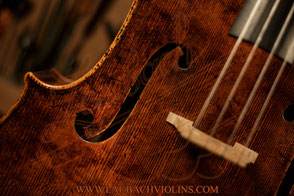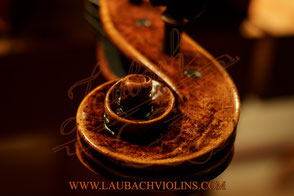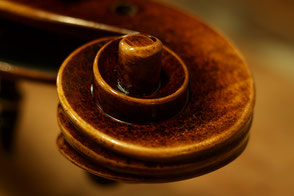Our Laubach Master CELLO Collection
The master instruments I make are handmade in the old Venetian and Cremonese style.
I am always looking for the best acoustic old wood for sound quality and appereance.
I pay great attention to the choice of well-seasoned timber of no less than 18 years old. The spruce wood comes principally from the North-East of Italy or from the south of Tyrol and from the Balkans comes maple.
The varnish from natural ingredients I use gives natural colouring to the woods. I always put 100% varnish by brush on the instrument which makes a thin and flexible skin enhancing the violin's venerable antique look.
I make violins, violas and cellos of different measurements following the old traditional model of the Cremonese and Venetian masters.

The workshop Laubach offers three main master cello models, which are built for different needs from solo players to musicians.
This model is designed for professional muzicant and students who desire an antique looking and old Italian sounding cello. The master Cello model generates a cheerful, upbeat ambiance that belies its value price. The varnish has a lovely orange brown patina appearing to be much older than it is. Don't let the price fool you, this instrument is superior to any rival.
This Laubach master cello is inspired by the great old cremonese and venetican masters.
This original Laubach cello with antique old italian look. It has a deep, vibrant tone and is available only in the antique style finish. This master cello model features a big tenor timbre. The beautiful golden brown varnish is layered over a yellow base which imparts an antique patina.
This master cello model from the workshop Laubach fits perfectly for students and hobby musicians, who want an affordable instrument. The Performer cello is taken from an original Stradivari work. This model instrument has a deep, cheerful resonance that would impress any maestro. The antique varnish is another example of Laubach's own master creation adding value and character to your possession.
Vintage top class Cello model for higher demands completely handcrafted and hand- varnished. The models and the appearances of the varnishes of these cellos depend on historical instruments.
These beautiful cellos are made of very nicely flamed maple and a high quality mountain spruce top, maple back and sides highly flamed. We select only the finest materials available – the wood of our master instruments is aged at least 8 – 19 years. Each instrument is varnished by hand and individually antiqued. This cello has beautiful orange-brown or red-brown antique hand varnish on amber primer with highly transparent gold-brown oil/spirit varnish.
We offer our cellos in two models: the Domenico Montagnana one and Antonio Stradivari model.
The accessories are made out of black African ebony wood. The tailpiece has 4 fine tuners which are either "Akusticus" or "Wittner", carbon lightweight spire tube end pin of German production. The bridge is made completely by hand from rare maple wood.
A special feature of this cello model is profound nobility of tone with stunning sound and aesthetic appeal.
Hand crafted Master Laubach Cello of selected European naturally aged tone wood and orange-brown hand oil/spirit varnished on amber primer, tastefully antiqued. Fingerboard and pegs are of solid ebony wood.
Fingerboard and pegs are of solid ebony wood. Fine Tuning tailpiece and Cello Larsen strings. This instrument suits perfectly for musicians that are looking for an cello that has an amazing sound without busting the bank
Top-class Master instrument for more demanding player, complet handcrafted from exquisite very rare, choice European tone woods, solid one-piece maple back, beautifully flamed, genuine purfling, highly transparent volatile gold-brown spirit-oil propolis varnish with natural resins hand-brushed varnish in the old tradition, tastefully antiqued, with wood tailpiece and "Larsen“, „Thomastik“ or „Pirastro“- strings. Each instrument has its own individual character.
All Master Cellos Laubach include an individual certificate of authenticity.
Every Laubach cello comes with a certificate of authenticity and a picture.

video Laubach Cello Antique Varnishing
... With inspiration drawn from Brescian, Cremonese and Venetian makers of the past, I strive to bring something personal and unique to each instrument. I look forward to continuing the tradition in the new century."
Briefly about the cello

The cello is a large, low-pitched musical instrument which is held between the player’s knees. Its four strings are tuned an octave lower than the viola.
Until the end of the 18th centruy, the violoncello was an instrument of accompaniment that played the lower voice and filled in the musical structures...
At the end of the 19th century, it was fitted with an adjustable end pin. This seemingly insignificant innovation was to give the violoncellist considerable freedom of movement and thus facilitate his handling the instrument.
-
A Brief History of the Italian Master Cello Instrument
The name violoncello is a diminutive of violone, a larger instrument of somewhat uncertain history and purpose. The cello did not gain instant success either as a solo instrument or as a member of the orchestra. There was a long tussle for supremacy between gamba and Cremona cello fanciers. The French thought the cello too noisy and in 1740 Hubert do Blanc pubished a book with the expansive title Defense de la Basse de Viole contre les enterprises du violon et les pretensions du violoncello, in which he expressed his deep disapproval of ‘the thick strinds demanding exaggerated pressure of the cello bow, and a tension that makes them shrill.’ But according to Roget North writing in 1728, the cello had been ‘a very hard and harsh sounding Base and nothing so soft and sweet as now.’ Music expressly for the Italian master cello was not written until the latter part of the 17th century, and then only to double the bass line. Beethoven was the first to exploit it as an individual voice of the orchestra.
Each string of each Cremona Master school instrument of the Italian violin family has its own characteristic timbre. With the master cello, if there is too much crossing over from string to string in the course of a passage it can sound choppy. Since the Venetian cello is supported by a spike and not by the left hand, fingering can include the thumb; thus more notes can be produced from one position on one string. So although bowing, the ‘soul’ of playing, is the same as for the Italian violin and viola, fingering is not.
Apart from each string having a different Italian timbre, opens strings sound different from stopped ones. The former have a somewhat inanimate sound partly because no Italian vibrato can be produced from them, although a feeble reflection of this can be produced by doing Venetian vibrato on an adjacent cello string. Composers sometimes specify which string they want played, or if they want the particular sound of an open master cello string.
Harmonics, which Rimsky-Korsakov considered ornamental but not essential, are impressive from a cello on account of the thickness of the strings and size of the body of the Venetian master instrument. But if the spike of the Italian cello were stuck in cotton wool there would be less resonance; the staging of a concert platform is often an acoustic resonator in itself and responds to a whole band of frequencies. Drums, the double bass and the cello are the only instruments of the orchestra that gain additional resonance from the floor.







